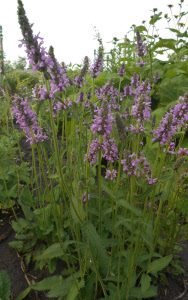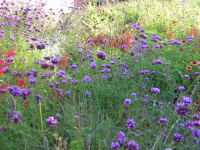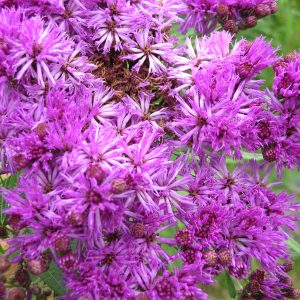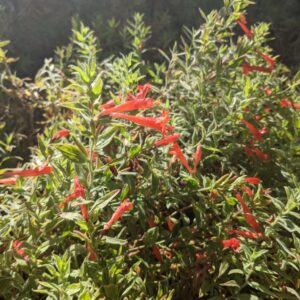Plants for Hummingbirds
Showing 73–78 of 78 results
-
Stachys officinalis syn. Betonica officinalis syn. Stachys betonica Bishop’s wort, Betony Z 4-8
Showy reddish-purple spikes of two-lipped tubes in May and June
Showy reddish-purple spikes of two-lipped tubes in May and June
Size: 18-24” x 12-18” slowly spreading
Care: sun in moist well-drained soil
Native: Europe and Asia
Wildlife Value: deer & walnut tolerant, attracts hummingbirdsOnce one of the most honored herbal medicines. Medicines were good if they had “as many virtues as Betony.” John Sauer, Colonial herbalist claimed “there is no illness brought on by cold in which Betony cannot be administered effectively.”
-
Symphoricarpos albus Snowberry Z 3-7
Small pink bell-shaped flowers turn into copious clusters of round, white berries, like miniature snowballs, grace this shrub from late summer through winter.
OUT OF STOCK
Small pink bell-shaped flowers turn into copious clusters of round, white berries, like miniature snowballs, grace this shrub from late summer through winter.
Size: 3-6’ x 3-6’
Care: sun to part shade in moist well-drained to well-drained soil
Native: Canada east to west coasts; US all states north from Virginia to California. Wisconsin native.
Wildlife Value: deer tolerant, attracts numerous birds including Hummingbirds, Towhees, Grouses, Robins, and Waxwings for nesting and food, although the fruit is poison to humans. Bees flock to the flowers’ pollen. Host for caterpillars of the Snowberry Sphinx moth and Snowberry Clearwing moth.Pauites of Oregon constructed cradle boards with the wood, sharpened the stem for digging tool and used its branches in a game of dice. The Nez Perce boiled sticks in water then used to remedy fevers, and encircled its branches around cradleboards to protect babies from ghosts. Flathead cured injured eyes with juice for the fruit and made a paste of its fruit, bark and leaves to remedy skin ailments and burns. For the Blackfoot the smoke from burning twigs blackened newly made pipes. Sioux made a diauretic from the fruit. Ojibwa speeded up convalescence for new mothers after giving birth with water infused with this. Shoshone made arrows from shoots for small birds. Collected for botany before 1753. Also collected on Lewis and Clark Expedition along the Missouri River west of Council Bluffs.
**LISTED AS OUT OF STOCK BECAUSE WE DO NOT SHIP THIS ITEM. IT IS AVAILABLE FOR PURCHASE AT OUR RETAIL LOCATION.
-
Verbena bonariensis Perennial Z 7-10, colder zones-reseeding annual
Small purple flowers atop tall leafless stems from July to October. Great see-through blooms for growing in back, middle or front of the garden.
Small purple flowers atop tall leafless stems from July to October. Great see-through blooms for growing in back, middle or front of the garden.
Size: 3-4’ x 8”
Care: full sun in moist, well-drained, fertile soil - self-seeder
Native: South America
Awards: Royal Horticultural Society Award of Merit & Missouri Botanic Garden Plant of Merit.Introduced to garden cultivation from its native Buenos Aires in 1726 by the Sherard brothers.
-
Vernonia fasciculata Prairie Ironweed Z 3-7
Dense clusters of fluffy petaled, true royal purple flowers atop unbranched stems, July-September
Dense clusters of fluffy petaled, true royal purple flowers atop unbranched stems, July-September
Size: 3-4’ x 2-3’
Care: sun to part shade in moist to moist well drained soil
Native: so central Canada to central & eastern US, Wisconsin native
Wildlife Value: Butterfly attractor – Fiery skipper. Host for Common buckeye butterfly. Deer & rabbit resistant.Lakota Sioux: “The leaves are formed into a sort of “plate” that keeps foreign matter from getting on meat. An infusion of the root is used to regulate menstrual periods.”
Collected by French planthunter André Michaux (1746-1802) who spent 11 years exploring America for plants. Vernonia named to honor Wm. Vernon (1666-1711) English botanist who collected plants in late 1600’s. -
Xerophyllum tenax Turkey beard, Indian basket grass Z 5-8
Plume of fragrant white flowers May-August on naked stalks rising from mound of grassy foliage, actually a lily.
OUT OF STOCK
Plume of fragrant white flowers May-August on naked stalks rising from mound of grassy foliage, actually a lily.
Size: 3-5’ x 24-30”
Care: sun to part shade in well-drained soil
Native: British Columbia, to Montana & WYSeveral western Indian tribes wove baskets & hats from the leaves & roasted the roots for food. Blackfoot applied the plant to wounds to stop bleeding and repair breaks & sprains. Collected by Meriwether Lewis June 15, 1806 just east of Weippe Prairie and west of Bitterroot Mountains in Idaho.
-
Zauschneria garetii syn Epilobium canum ssp. garrettii Hummingbird trumpet, California fuchsia, Garrett’s Firechalice Z 5-9
Vibrant orange-red tubes in late summer, spreading by root, form a colorful groundcover.
Vibrant orange-red tubes in late summer, spreading by root, form a colorful groundcover.
Size: 12” x 18-24”
Care: sun to part shade in well-drained soil
Native: Kingston Mountains in CA, Utah, Idaho & Wyoming
Wildlife Value: Attracts hummingbirds, birds and butterflies, Deer and rabbit resistantCollected in Utah’s Big Cottonweed Canyon in 1906 by A.O. Garrett (1870-1948), prolific Utah planthunter.





